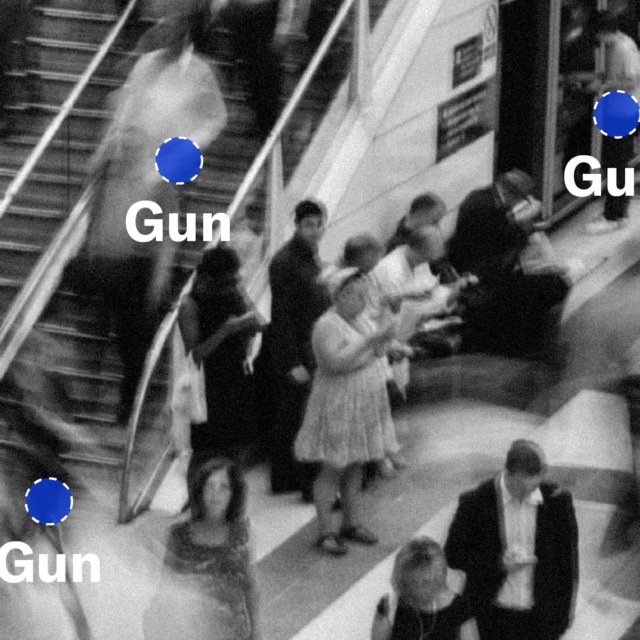Fear versus Facts: Gun Violence is Definitely Down
Is violent crime on the rise in the United States? This election season, if you’re listening to fear-mongering media1Matthew J. Dolliver et al., “Examining the Relationship between Media Consumption, Fear of Crime, and Support for Controversial Criminal Justice Policies Using a Nationally Representative Sample,” Journal of Contemporary Criminal Justice 34, no. 4 (November 1, 2018): 399–420, https://doi.org/10.1177/1043986218787734; Philip Bump, “Crime Is Down, though Fox News Viewers Might Not Be Aware,” December 18, 2023, https://www.washingtonpost.com/politics/2023/12/18/crime-fbi-fox-news/; William Vaillancourt,”Fox News Hosts Struggle to Process Falling Crime Rates,” March 5, 2024, https://www.thedailybeast.com/fox-news-hosts-struggle-to-process-falling-crime-rates.
and campaign speeches,2Jesse H. Rhodes and Amber B. Vayo, “The Historical Presidency: Fear and Loathing in Presidential Candidate Rhetoric, 19522016,” Presidential Studies Quarterly 49, no. 4 (December 2019): 909-931, https://doi.org/10.1111/psq.12512; CNN Staff, “Fact Check: Trump Makes More Than 20 False Claims in RNC Acceptance Speech,” July 19, 2024, https://www.cnn.com/2024/07/18/politics/fact-checking-night-4-republican-national-convention-trump/index.html; Daniel Dale, “Fact Check: Trump Falsely Claims US Crimes Stats Are Only Going Up. Most Went Down Last Year, Including Masive Drop in Murder,” April 3, 2024, https://www.cnn.com/2024/04/03/politics/fact-check-trump-falsely-claims-us-crime-stats-are-only-going-up-most-went-down-last-year-including-massive-drop-in-murder/index.html. the answer is surely “yes.”
The data tells a different story. Following coordinated efforts to address gun violence from the federal down to the community level, American cities are becoming safer each year.
For the past two and a half years, violent crime has been trending downward, according to nearly every major data source.3Percent changes were calculated using rates whenever this data was publicly available. Count-based changes were calculated for incomplete years and Gun Violence Archive data. Federal Bureau of Investigation, “Crime Data Explorer,” NIBRS, June 10, 2024, https://cde.ucr.cjis.gov/; Ernesto Lopez and Bobby Boxerman, “Crime Trends in U.S. Cities: Year-End 2023 Update,” Council on Criminal Justice, January 25, 2024, https://counciloncj.org/crime-trends-in-u-s-cities-year-end-2023-update/; AH Datalytics, “YTD Murder Comparison—Dashboards,” Local Police Department Data, July 24, 2024, https://www.ahdatalytics.com/dashboards/ytd-murder-comparison/; Gun Violence Archive, Assault-Related Fatal and Nonfatal Shootings, 2019–2024, accessed July 26, 2024, https://www.gunviolencearchive.org/; Jeff Asher, “Growing Evidence That Murder Fell at a Record Pace in 2023,” Jeff-Alytics (blog), July 15, 2024, https://jasher.substack.com/p/growing-evidence-that-murder-fell. Only the National Crime Victimization Survey (NCVS) shows inconsistent trends. Criminologists cite the NCVS’s exclusion of homicides and children under age 12, capturing of incidents not reported to police, large confidence intervals, and data reflecting a year prior to its stated year as being responsible for variations between NCVS and FBI crime data. Bureau of Justice Statistics, “2019–2022 National Crime Victimization Survey,” July 26, 2024, https://ncvs.bjs.ojp.gov/multi-year-trends/characteristic; Rachel E. Morgan and Alexandra Thompson, “The Nation’s Two Crime Measures, 2011–2020,” Bureau of Justice Statistics, February 2022, https://bjs.ojp.gov/library/publications/nations-two-crime-measures-2011-2020.
This holds true for overall violent crimes, homicides, aggravated assaults, and incidents specifically involving guns—the last of which is unsurprising, given that guns are the leading weapon used in American acts of violence.4In 2022, guns were involved in 32 percent of overall violent offenses, 78 percent of homicides, and 34 percent of aggravated assaults. Everytown Research analysis of Federal Bureau of Investigation, “Crime Data Explorer,” NIBRS, June 10, 2024, https://cde.ucr.cjis.gov/. For example, FBI data reveal that annual homicides decreased by 7 percent in 2022, 13 percent in 2023, and 26 percent through the first quarter of 2024.5Federal Bureau of Investigation, “Crime Data Explorer: Crime,” May 1, 2023, https://cde.ucr.cjis.gov/LATEST/webapp/#/pages/explorer/crime/crime-trend; Adam Gabbatt, “FBI Data Shows Us Crime Plummeted in 2023 but Experts Warn Report Is Incomplete,” The Guardian, March 19, 2024, https://www.theguardian.com/us-news/2024/mar/19/fbi-data-shows-us-crime-plummeted-2023; Federal Bureau of Investigation, “FBI Releases 2024 Quarterly Crime Report and Use-of-Force Data Update,” press release, June 10, 2024, https://www.fbi.gov/news/press-releases/fbi-releases-2024-quarterly-crime-report-and-use-of-force-data-update. In other words, homicides are continuing to drop by increasingly large margins. These most recent FBI figures are preliminary as we await some law enforcement agencies that have not yet reported and final vetting. However, multiple sources report similar patterns,6Across the over 250 cities that publicly report homicide data, AH Datalytics found the following annual/year-to-date homicide changes: -6 percent in 2022, -12 percent in 2023, and -17 percent January–July 2024. In a sample of 32 cities with available homicide data, the Council on Criminal Justice found: -5 percent in 2022 and -11 percent in 2023. AH Datalytics, “YTD Murder Comparison—Dashboards,” July 24, 2024, https://www.ahdatalytics.com/dashboards/ytd-murder-comparison/; Ernesto Lopez and Bobby Boxerman, “Crime Trends in U.S. Cities: Year-End 2023 Update,” Council on Criminal Justice, January 25, 2024, https://counciloncj.org/crime-trends-in-u-s-cities-year-end-2023-update/.
indicating that the United States is likely experiencing the sharpest single-year homicide decrease in recorded history.7Jeff Asher, “Crime in 2023: Murder Plummeted, Violent and Property Crime Likely Fell Nationally,” Jeff-Alytics (blog), December 11, 2023, https://jasher.substack.com/p/crime-in-2023-murder-plummeted-violent.
-14%
Assault-related gun deaths and injuries dropped 14 percent in the first six months of 2024.
Source: Everytown Research analysis of Gun Violence Archive, Assault-Related Fatal and Nonfatal Shootings, accessed July 26, 2024, https://www.gunviolencearchive.org/. Count percent change and difference: January–June 2023 vs. January–June 2024.
Specific to gun violence, assault-related gun deaths and injuries have seen similar decreases, dropping 20 and 14 percent, respectively, from the 2021 gun violence peaks that coincided with the COVID-19 pandemic.8Everytown Research analysis of Gun Violence Archive, Assault-Related Fatal and Nonfatal Shootings, accessed July 26, 2024, https://www.gunviolencearchive.org/. Count percent change: 2021 vs. 2023. In the first six months of 2024 alone, these gun deaths and injuries both dropped yet again by another 14 percent, relative to the same period the year prior—already saving 1,048 lives and avoiding 2,275 injuries.9 Everytown Research analysis of Gun Violence Archive, Assault-Related Fatal and Nonfatal Shootings, accessed July 26, 2024, https://www.gunviolencearchive.org/. Count percent change and difference: January–June 2023 vs. January–June 2024.
Without a doubt, the lives saved and trauma spared by this progress is most important. But these declines have also saved taxpayers millions, money that could instead be spent on beneficial investments in health, education, and targeted programs that we know help to prevent this violence from happening in the first place. Each gun homicide costs American taxpayers an average of $709,985 from government expenses on medical and mental healthcare, ambulances, police investigations, and criminal justice costs.10Everytown for Gun Safety Support Fund, “Calculate the Economic Cost of Gun Violence,” February 9, 2023, https://everytownresearch.org/report/economic-cost-calculator/. Gun assault injuries average $41,299 each.11Everytown for Gun Safety Support Fund, “Calculate the Economic Cost of Gun Violence,” February 9, 2023, https://everytownresearch.org/report/economic-cost-calculator/. In just the first six months of 2024, safer cities have also meant an estimated $838,019,544 in taxpayer savings.12Everytown for Gun Safety Support Fund, “Calculate the Economic Cost of Gun Violence”; Everytown Research analysis of Gun Violence Archive, Assault-Related Fatal and Nonfatal Shootings, accessed July 26, 2024, https://www.gunviolencearchive.org/, Count difference: January–June 2023 vs. January–June 2024. This decrease of 1,048 assault-related fatal shooting deaths and 2,275 assault-related nonfatal shooting injuries translates to $838,019,544 in taxpayer savings. Putting these funds back into city coffers could support over 250,000 young people at risk for violence to benefit from a summer employment program, offering paid work, mentoring, and a supportive environment during a time of year when violence is at its highest levels.13The average cost of enrolling a young person in a summer youth employment program is $3,331. Kathryn Schnippel et al., “Costs of Summer Youth Employment to Prevent Violence: An Analysis and Implementer’s Tool,” Journal of Urban Health, August 8, 2023, https://doi.org/10.1007/s11524-023-00753-8.
$838M
Taxpayer savings from reduced gun violence through the first six months of 2024.
Source: Everytown for Gun Safety Support Fund, “Calculate the Economic Cost of Gun Violence,” February 9, 2023, https://everytownresearch.org/report/economic-cost-calculator/; Everytown Research analysis of Gun Violence Archive, Assault-Related Fatal and Nonfatal Shootings, accessed July 26, 2024, https://www.gunviolencearchive.org/, Count difference: January–June 2023 vs. January–June 2024.
A lot can be said about what’s likely driving violence down, much of which is tied to post-COVID “returns to normal,” whereby social services, employment opportunities, and after-school activities for young people are all improving.14Council on Criminal Justice, “Trends in Homicide: What You Need to Know,” December 2023, https://counciloncj.org/homicide-trends-report/; John Roman, “Why Did Crime Decline in 2023?,” External Processing (blog), December 30, 2023, https://johnkroman.substack.com/p/why-did-crime-decline-in-2023. But importantly during this period, the federal government also took several meaningful steps to activate multipronged gun violence prevention efforts, including the 2021 American Rescue Plan, the 2022 Bipartisan Safer Communities Act,15Everytown for Gun Safety, “What Is the Bipartisan Safer Communities Act?,” June 21, 2022, https://www.everytown.org/what-is-the-bipartisan-safer-communities-act/; White House Office of Gun Violence Prevention, “A Report on the Implementation of the Bipartisan Safer Communities Act,” June 2024, https://www.whitehouse.gov/wp-content/uploads/2024/06/A-Report-on-the-Implementation-of-the-Bipartisan-Safer-Communities-Act.pdf. and the 2023 formation of the White House Office of Gun Violence Prevention. Collectively, these actions allowed cities across the country to scale up data- and community-driven violence prevention strategies by:
- Expanding the presence of community violence intervention programs in the small social networks and geographic locations where gun violence remains the stickiest;16White House Office of Gun Violence Prevention, “A Report on the Implementation of the Bipartisan Safer Communities Act,” June 2024, https://www.whitehouse.gov/wp-content/uploads/2024/06/A-Report-on-the-Implementation-of-the-Bipartisan-Safer-Communities-Act.pdf; US Department of Justice, Office of Justice Programs, “Community Violence Intervention: A Collaborative Approach to Addressing Community Violence,” March 22, 2024, https://www.ojp.gov/topics/community-violence-intervention.
- Establishing local offices of violence prevention, capable of coordinating these efforts;17National Offices of Violence Prevention Network, “National Offices of Violence Prevention Network Landscape Scan,” May 2023, https://ovpnetwork.org/wp-content/uploads/2023/09/OVP-Report_V15_90823.pdf.
- Leveraging quality and timely data to inform and evaluate public safety initiatives;18John Roman and Philip Cook, “Improving Data Infrastructure to Reduce Firearms Violence,” National Opinion Research Center (NORC) at the University of Chicago, October 2021, https://www.norc.org/content/dam/norc-org/pdfs/Improving%20Data%20Infrastructure%20to%20Reduce%20Firearms%20Violence_Final%20Report.pdf; John Roman, “A Blueprint for a US Firearms Data Infrastructure: Final Recommendations of the Expert Panel on Firearms Data Infrastructure,” National Opinion Research Center (NORC) at the University of Chicago, October 2020, https://www.norc.org/content/dam/norc-org/pdfs/A%20Blueprint%20for%20a%20U.S.%20Firearms%20Data%20Infrastructure_NORC%20Expert%20Panel%20Final%20Report_October%202020.pdf.
and - Enhancing background checks and gun trafficking prevention efforts.19 White House Office of Gun Violence Prevention, “A Report on the Implementation of the Bipartisan Safer Communities Act,” June 2024, https://www.whitehouse.gov/wp-content/uploads/2024/06/A-Report-on-the-Implementation-of-the-Bipartisan-Safer-Communities-Act.pdf; Everytown for Gun Safety, “What Is the Bipartisan Safer Communities Act?,” June 21, 2022, https://www.everytown.org/what-is-the-bipartisan-safer-communities-act/; Everytown for Gun Safety, “How the Bipartisan Safer Communities Act is Already Saving Lives,” July 13, 2023, https://www.everytown.org/how-the-bipartisan-safer-communities-act-is-already-saving-lives/; Everytown for Gun Safety, “Everytown for Gun Safety, Moms Demand Action and Students Demand Action Recognize Two-Year Mark of Bipartisan Safer Communities Act,” press release, June 25, 2024, https://www.everytown.org/press/everytown-for-gun-safety-moms-demand-action-and-students-demand-action-recognize-two-year-mark-of-bipartisan-safer-communities-act/.
While this is worth celebrating, every life taken or forever changed due to gun violence is an avoidable tragedy. There’s certainly more progress to be made. Not all of these policies or investments have been fully implemented yet, nor have we fully reduced violence back to its pre-2020 level. Sustained funding, implementation of existing policies and laws, and support for hyperlocal strategies are necessary to continue this progress in gun violence reduction across the United States in the years to come. That path has been laid; it’s now on us to eschew the political fiction and continue following the facts to a safer tomorrow.
Learn More:
Everytown Research & Policy is a program of Everytown for Gun Safety Support Fund, an independent, non-partisan organization dedicated to understanding and reducing gun violence. Everytown Research & Policy works to do so by conducting methodologically rigorous research, supporting evidence-based policies, and communicating this knowledge to the American public.




